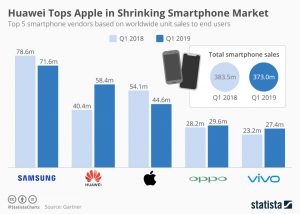After years of explosive growth, global smartphone shipments declined for the second consecutive year in 2018. That negative trend continued in the first quarter of 2019, when global smartphone sales declined by 2.7 percent according to Gartner. The market research company attributes the continued weakness to slowing innovation in flagship smartphones, rising prices and, as a consequence of the former two, longer replacement cycles. The world’s two largest smartphone markets, namely the United States and China, contracted by 15.8 and 3.2 percent, respectively, indicating that the premium segment of the market is hit harder by the slowdown than lower-priced devices.
“Demand for premium smartphones remained lower than for basic smartphones,” said Anshul Gupta, senior research editor at Gartner, explaining why last year’s market leaders Samsung and Apple saw their sales decline by 9 and 18 percent in the first quarter, respectively. Meanwhile Huawei defied the negative headlines surrounding its ban in the United States and elsewhere and saw its sales increase by a whopping 45 percent compared to the first quarter of 2018. “Huawei did particularly well in two of its biggest regions, Europe and Greater China, where its smartphone sales grew by 69% and 33%, respectively,” said Mr. Gupta.
While Huawei did overtake Apple to become the world’s second largest smartphone maker in the first three months of 2019, it needs to be noted that the negative effect of what happened to Huawei in the past few weeks, will only become noticeable in the second quarter of 2019. If the company really loses access to Google apps and services, which seems likely at the moment, sales of Huawei smartphones outside of China will probably nosedive and the company could quickly lose its market-leading position in many European markets.
source: statista

Ask me anything
Explore related questions





